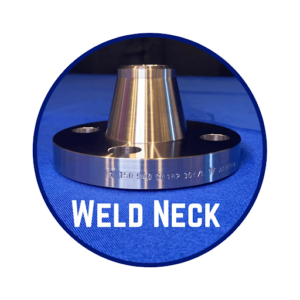Weld neck flanges, also known as welding neck flanges, are an important part of various industries, providing a strong connection between pipes, valves, and equipment. These specialized flanges have unique features that make them useful in challenging situations. Let’s explore different aspects of weld neck flanges, including their types, uses, materials, dimensions, and standards.
Image source:Texas Flange
Types of Weld Neck Flanges
Weld neck flanges come in two main designs:
- Standard Weld Neck Flanges: These flanges are used with butt weld fittings, making them a crucial part of many piping systems. They work with various face types and different pressure classes.
Image source:Texas Flange
- Long Weld Neck Flanges: Also called nozzle flanges or “long neck” flanges, these special flanges are mainly designed for pressure vessel and tank fabrication. They act as a one-piece replacement for standard weld neck and pipe weld combinations.
Image source:Texas Flange
Applications of Weld Neck Flanges
Weld neck flanges are used in situations where conditions are tough. Some common scenarios include:
- High-pressure systems
- Wide temperature and pressure fluctuations
- High-temperature environments
- Handling volatile and hazardous fluids
- Working in very cold conditions
These flanges are built to handle such challenging conditions, thanks to their strong construction and excellent stress distribution capabilities.
Materials of Weld Neck Flanges
Welding neck flanges come in various materials, chosen to meet industry standards and application needs. The material used depends on factors like temperature, pressure, and the type of fluids being transported. Common materials for weld neck flanges include:
- Carbon steel (ASTM A105)
- Alloy steel (ASTM A182, with variations like F11 and F22)
- Stainless steel (ASTM A182, including grades like F304/F304L, F316/F316L)
- Duplex steel (UNS S31803)
- Nickel alloys (e.g., Inconel 600 and 625, Hastelloy C22 and C276)
The material choice ensures that the weld neck flange can handle the specific operating conditions while maintaining its strength.
Dimensions and Sizes
Weld neck flanges come in various sizes to fit pipes of different diameters. Common dimensions for weld neck flanges under ASME B16.5 (Class 150) include:
Image source:Texas Flange
- 1/2″ NPS with an inside diameter of 0.62″ and an outside diameter of 3.50″.
- 3/4″ NPS with an inside diameter of 0.82″ and an outside diameter of 3.88″.
- 1″ NPS with an inside diameter of 1.05″ and an outside diameter of 4.25″.
- 2″ NPS with an inside diameter of 2.07″ and an outside diameter of 6.00″.
- 5″ NPS with an inside diameter of 5.05″ and an outside diameter of 10.00″.
- 6″ NPS with an inside diameter of 6.065″ and an outside diameter of 11.00″.
- 10″ NPS with an inside diameter of 10.02″ and an outside diameter of 16.00″.
- 20″ NPS with an inside diameter of 19.25″ and an outside diameter of 27.50″.
- 24″ NPS with an inside diameter of 23.25″ and an outside diameter of 32.00″.
Custom sizing options are also available for larger outer diameters up to 60″. Pressure classes range from Class 150 to Class 2500, with flange face types including RF (Raised Face) and RTJ (Ring Type Joint).
Standards for Weld Neck Flanges
The manufacturing and usage of weld neck flanges are governed by recognized standards to ensure consistency and safety. Some relevant standards include:
- ASTM A105 for carbon steel weld neck flanges
- ASTM A182 for alloy and stainless steel weld neck flanges, with variations for different grades
- ASME B16.5 for flange dimensions and specifications
- ASME B16.47 for large diameter flanges
- BS 3293 for British standards
- DIN 2630 PN standards for European applications
Companies should confirm material standards, outer diameters, pressure classes, face types, and thickness schedules before ordering weld neck flanges to ensure they meet specific application needs.
Non-Destructive Testing (NDT) Techniques
Weld neck flanges undergo rigorous testing to ensure their quality and performance. Non-destructive testing techniques like phased array (ultrasonic NDT), magnetic particle inspection (MPI), dye penetrant inspection (DPI), radiographic testing (RT), and ultrasonic testing (UT) are used to check the quality of butt welds and identify any internal damage on the sealing face.
Image source:Texas Flange
ASME Standards
The American Society of Mechanical Engineers (ASME) establishes standards for the installation, maintenance, and testing of weld neck flanges. ASME B16.5 and ASME B31.3 are notable standards that provide detailed requirements and guidelines for the proper use of weld neck flanges in various industries
Frequently Asked Questions (FAQs)
- What is a Weld Neck Flange?
A Weld Neck Flange, often called a welding neck flange, is a type of flange designed for welding to pipes. It has a long-tapered hub that provides mechanical strength and resistance to deformation.
- What are the Main Types of Weld Neck Flanges?
There are two primary types: Standard Weld Neck Flanges, used with butt weld fittings, and Long Weld Neck Flanges, designed for pressure vessels and tanks.
- Where are Weld Neck Flanges Commonly Used?
Weld Neck Flanges are ideal for applications with challenging conditions, such as high pressure, extreme temperatures, volatile fluids, or sub-zero environments.
- What Materials are Weld Neck Flanges Made From?
Weld Neck Flanges can be crafted from various materials, including carbon steel, alloy steel (e.g., ASTM A182 F11, F22), stainless steel (e.g., ASTM A182 F304/F304L, F316/F316L), and nickel alloys (e.g., Inconel 600, Hastelloy C22).
- What Are the Common Dimensions and Sizes of Weld Neck Flanges?
Weld Neck Flanges are available in a wide range of sizes, with dimensions tailored to match pipe inside diameters. For example, a 1/2″ NPS weld neck flange has an inside diameter of 0.62″ and an outside diameter of 3.50″.
- What Pressure Classes Are Available for Weld Neck Flanges?
Weld Neck Flanges come in various pressure classes, including Class 150, 300, 400, 600, 900, 1500, and 2500, as well as PN 2.5 to PN 250.
- What Are the Common Face Types for Weld Neck Flanges?
Common face types include Raised Face (RF) and Ring Type Joint (RTJ). RF flanges have a small raised portion surrounding the bore, while RTJ flanges have a special groove for metal gasket seating.
- What Standards Govern the Use of Weld Neck Flanges?
Weld Neck Flanges adhere to industry standards such as ASTM A105 for carbon steel, ASTM A182 for alloy and stainless steel, ASME B16.5 for dimensions, ASME B16.47 for large diameter flanges, BS 3293, and DIN 2630 PN standards.
- How Are Weld Neck Flanges Tested for Quality?
Non-Destructive Testing (NDT) techniques like phased array, magnetic particle inspection, dye penetrant inspection, radiographic testing, and ultrasonic testing are employed to ensure weld integrity and detect internal damage on sealing faces.
- Why Choose Weld Neck Flanges Despite Higher Costs?
Weld Neck Flanges may come at a higher cost, but they offer superior reliability and safety, making them an essential choice for demanding applications where performance is critical.
Conclusion
Weld neck flanges are essential components in industries where reliability and performance are crucial. Whether in high-pressure systems, extreme temperatures, or critical applications, these flanges play a vital role in ensuring the integrity of piping connections.
Companies considering the use of weld neck flanges should carefully consider factors like material selection, sizing, and adherence to industry standards. While they may come at a higher cost, the benefits of safety and reliability in demanding conditions make weld neck flanges a valuable choice.
For visual references and detailed information of welding flanges, you can visit www.texasflange.com




